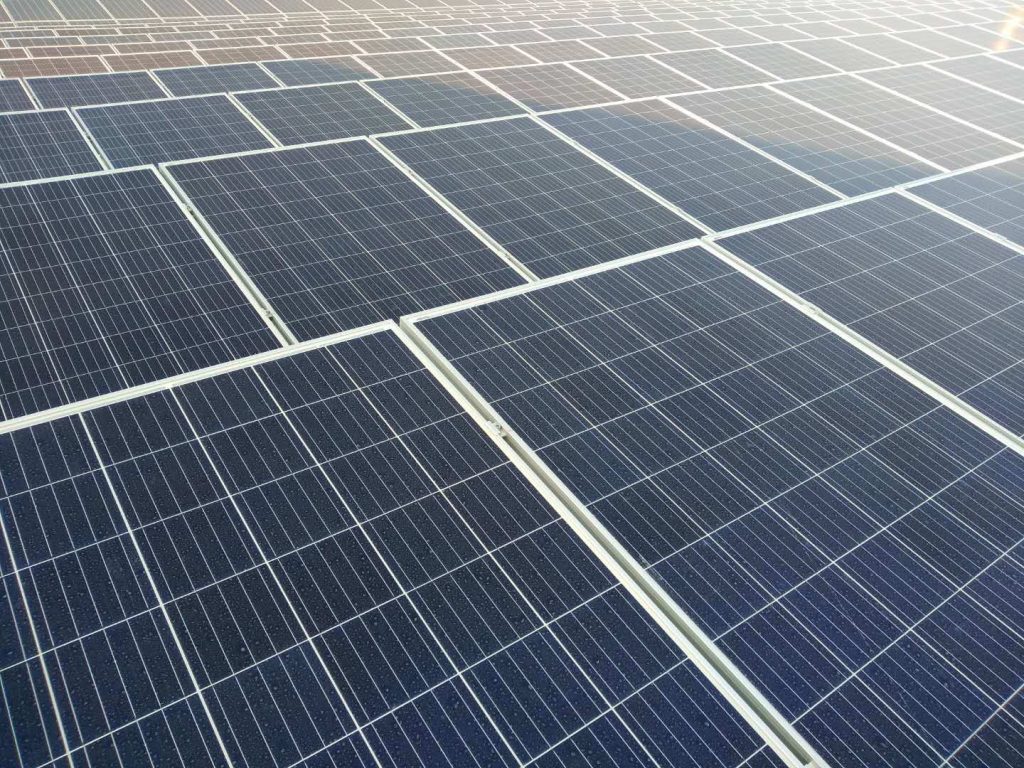The mainstream panels currently used in the market are divided into: 1. Monocrystalline solar panels. 2. Polycrystalline solar panels. 3. Thin-film solar panels. The differences between the three are:
- Monocrystalline solar panels
The photoelectric conversion efficiency of monocrystalline silicon solar cells is about 18%, and the highest reaches 24%. This is the highest photoelectric conversion efficiency among all types of solar cells, but the production cost is very high. Since monocrystalline silicon is generally encapsulated with tempered glass and waterproof resin, it is durable and has a service life of up to 25 years. (As shown in the figure below, the four corners of the cells in the monocrystalline silicon panel are smooth! There is a curve.)

- Polycrystalline solar panels
The production process of polycrystalline silicon solar cells is similar to that of monocrystalline silicon solar cells, but the photoelectric conversion efficiency of polycrystalline silicon solar cells is much lower, and its photoelectric conversion efficiency is about 16%. In terms of production cost, it is cheaper than monocrystalline silicon solar cells, the material is simple to manufacture, saves electricity consumption, and the total production cost is low, so it has been widely developed. In terms of performance-price ratio, monocrystalline silicon solar cells are slightly better. (As shown in the figure below, polycrystalline cells have no rounded corners. They are easy to distinguish from monocrystalline ones)
- Thin-film solar panels
Amorphous silicon solar cells are a new type of thin-film solar cells that appeared in 1976. They are completely different from monocrystalline silicon and polycrystalline silicon solar cells in terms of production methods. The process is greatly simplified, silicon material consumption is very low, and power consumption is lower. Its main advantage is that it can generate electricity even under weak light conditions. However, the main problem of amorphous silicon solar cells is that the photoelectric conversion efficiency is low, the international advanced level is about 10%, and it is not stable enough. As time goes by, its conversion efficiency decays.
Let’s take a look at the components: 1. Tempered glass, 2. EVA 3. Cells 4. EVA 5. Backplane 6. Aluminum alloy protective laminate 7. Junction box 8. Silicone. Let’s talk about the specific functions of these components separately.
- Monocrystalline solar panels
The components of monocrystalline panels are the same, except that its cells are made of monocrystalline silicon. (Q: What is monocrystalline silicon? A: A single crystal of silicon. A crystal with a basically complete lattice structure. Different directions have different properties and are a good semiconductor material. The purity requirement is 99.9999%, or even above 99.9999999%. It is used to manufacture semiconductor devices, solar cells, etc. It is made of high-purity polycrystalline silicon pulled in a single crystal furnace.) The advantage of monocrystalline silicon is that the conversion rate is higher than that of polycrystalline silicon. It can generate more electricity in the same area! It reduces land rent and bracket costs. And in terms of performance (attenuation, etc.), it is slightly better than polycrystalline silicon, but in terms of manufacturing cost, it is higher than polycrystalline silicon. Therefore, the price of monocrystalline panels is higher than that of polycrystalline silicon panels!
- Polycrystalline solar panels
The composition and structure of polycrystalline panels are exactly the same as those of monocrystalline panels, except that their cells are made of polycrystalline silicon. After the introduction of polycrystalline panels, they have been very popular in the market because of their low price and the fact that their performance is not much different from that of monocrystalline panels! Moreover, due to the continuous technological innovation in recent years, the performance and conversion rate of polycrystalline silicon panels are not much different from those of polycrystalline panels, and can be almost ignored. However, there is a big difference in price (before the 531 new policy, the price of single crystal and polycrystalline can differ by a few cents per watt). Therefore, polycrystalline silicon is more popular in the market. (However, after the 531 new policy, due to the high price of monocrystalline panels and poor returns, the price of monocrystalline panels has dropped significantly. As of November, the price difference between monocrystalline and polycrystalline panels is not very large.)
- Thin-film panels
The price of thin-film panels is still relatively high compared to silicon crystal panels. And there is no advantage in conversion rate, but its effect on weak light effect and sunlight blocking is better than that of single and polycrystalline panels! It is more suitable for use in areas with poor geographical location and perennial shadow blocking.
Summary: There is no requirement for the type of panel, so the price of single and polycrystalline is more suitable! If the site is limited and you want to install more capacity, choose monocrystalline! If the lighting is poor and there are shadows all year round, and you are not deliberately pursuing investment returns, choose film!
